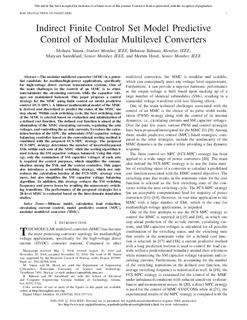| dc.contributor.author | Vatani, Mohsen | |
| dc.contributor.author | Behrooz, Bahrani | |
| dc.contributor.author | Saeedifard, Maryam | |
| dc.contributor.author | Hovd, Morten | |
| dc.date.accessioned | 2015-01-13T14:03:24Z | |
| dc.date.accessioned | 2015-09-02T09:13:25Z | |
| dc.date.available | 2015-01-13T14:03:24Z | |
| dc.date.available | 2015-09-02T09:13:25Z | |
| dc.date.issued | 2015 | |
| dc.identifier.citation | IEEE Transactions on Smart Grid 2015, 6(3) | nb_NO |
| dc.identifier.issn | 1949-3053 | |
| dc.identifier.uri | http://hdl.handle.net/11250/298417 | |
| dc.description.abstract | The modular multilevel converter (MMC) is a potential
candidate for medium/high-power applications, specifically
for high-voltage direct current transmission systems. One of
the main challenges in the control of an MMC is to eliminate/
minimize the circulating currents while the capacitor voltages
are maintained balanced. This paper proposes a control
strategy for the MMC using finite control set model predictive
control (FCS-MPC). A bilinear mathematical model of the MMC
is derived and discretized to predict the states of the MMC one
step ahead. Within each switching cycle, the best switching state
of the MMC is selected based on evaluation and minimization of
a defined cost function. The defined cost function is aimed at the
elimination of the MMC circulating currents, regulating the arm
voltages, and controlling the ac-side currents. To reduce the calculation
burden of the MPC, the submodule (SM) capacitor voltage
balancing controller based on the conventional sorting method is
combined with the proposed FCS-MPC strategy. The proposed
FCS-MPC strategy determines the number of inserted/bypassed
SMs within each arm of the MMC while the sorting algorithm is
used to keep the SM capacitor voltages balanced. Using this strategy,
only the summation of SM capacitor voltages of each arm
is required for control purposes, which simplifies the communication
among the SMs and the central controller. This paper
also introduces a modified switching strategy, which not only
reduces the calculation burden of the FCS-MPC strategy even
more, but also simplifies the SM capacitor voltage balancing
algorithm. In addition, this strategy reduces the SM switching
frequency and power losses by avoiding the unnecessary switching
transitions. The performance of the proposed strategies for a
20-level MMC is evaluated based on the time-domain simulation
studies. | nb_NO |
| dc.language.iso | eng | nb_NO |
| dc.publisher | Institute of Electrical and Electronics Engineers | nb_NO |
| dc.title | Indirect Finite Control Set Model Predictive Control of Modular Multilevel Converters | nb_NO |
| dc.type | Journal article | nb_NO |
| dc.type | Peer reviewed | en_GB |
| dc.date.updated | 2015-01-13T14:03:24Z | |
| dc.source.pagenumber | 1520-1529 | nb_NO |
| dc.source.volume | 6 | nb_NO |
| dc.source.journal | IEEE Transactions on Smart Grid | nb_NO |
| dc.source.issue | 3 | nb_NO |
| dc.identifier.doi | 10.1109/TSG.2014.2377112 | |
| dc.identifier.cristin | 1196840 | |
| dc.description.localcode | (C) 2014 IEEE. This is the authors' accepted and refereed manuscript to the article. | nb_NO |
